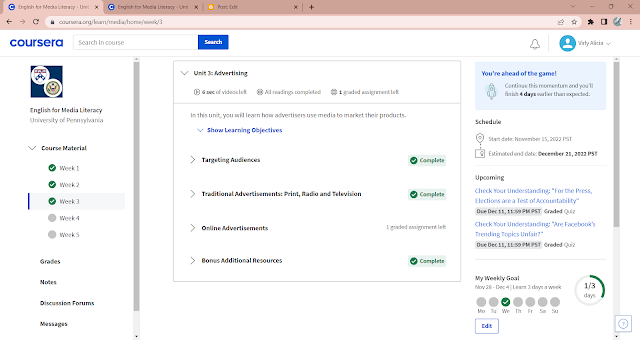My Path to Media Literacy: Enrolling in the University of Pennsylvania's Coursera Course
In today’s world, we are constantly surrounded by media. From the news on our phones to advertisements on TV, media plays a huge role in shaping our perceptions and decisions. So, how do we navigate through this media overload? How do we critically engage with the content we consume every day? That’s where media literacy comes in, and my recent course in English for Media Literacy at the University of Pennsylvania helped me get a deeper understanding of how to become a more discerning media consumer.
Let me walk you through what I learned in the first few weeks of this engaging course.
Week 1: What Exactly is Media Literacy?
The first week of the course was all about getting to the heart of what media literacy is and why it’s essential in today’s media-driven world.
Key Takeaways:
-
Understanding Media Literacy: The course kicked off by introducing the concept of media literacy—essentially, the ability to access, analyze, evaluate, and create media in various forms. This foundation allowed me to realize that simply consuming media is not enough. It’s about critical thinking—questioning the sources, analyzing messages, and understanding the power dynamics behind them.
-
Reading Strategies: We learned how to apply reading strategies like skimming, scanning, and identifying the main ideas when we read texts. This was a game-changer for me, as it made reading more efficient and focused.
-
Engagement with Multimedia: The course wasn’t just about reading articles. It included a mix of multimedia—videos, articles, and interactive games that helped reinforce the key concepts. Through quizzes and discussion posts, I was able to test my comprehension and reflect on how these strategies can be applied in real-world media consumption.
This week set the tone for the course, encouraging us to be proactive rather than passive consumers of media.
Week 2: Traditional vs. Social Media—What's the Difference?
Week 2 was all about diving into traditional versus social media. In today’s digital world, it’s crucial to understand how these two types of media operate and how they differ.
Key Takeaways:
-
Traditional Media: We examined classic forms of media like newspapers, television, and radio. These are typically more structured and regulated.
-
Social Media: Social media, on the other hand, gives individuals a platform to create and share content. This week, we looked at how social media has changed the game by enabling interactivity and instant access to global information.
-
Comparing the Two: We learned to use comparative adjectives to weigh the advantages and disadvantages of both types of media. Social media, for example, allows for immediacy, but traditional media can often provide more reliable and well-researched content.
-
Reductions: The week also focused on learning reductions in spoken and written English. This is essential for understanding real-life language in both traditional media (like radio ads) and social media (like casual posts or tweets).
By the end of this unit, I had a much clearer understanding of how both media types serve different needs and how to approach each with a critical eye.
Week 3: The Power of Advertising in Media
Week 3 introduced me to the world of advertising—one of the most pervasive forms of media we interact with daily. This unit explored how advertisers craft messages to influence our purchasing decisions.
Key Takeaways:
-
What Makes an Advertisement: We started by breaking down the components of an advertisement. It’s not just about flashy visuals and catchy slogans. Advertisements are carefully crafted to communicate specific messages to specific audiences.
-
Targeting Audiences: One of the most eye-opening aspects of this unit was learning how advertisers target particular demographics. Whether it’s through TV commercials, online ads, or print media, advertisers are strategic about where and how they reach potential customers.
-
Adjectives and Intensifiers: We practiced how to use adjectives to describe products and learned how to enhance these descriptions with intensifiers (words like “extremely” or “incredibly”). This skill is especially useful when analyzing ads—whether in print, on TV, or online.
-
The Changing Face of Advertising: A major focus of this unit was on the evolution of advertisements, especially how the Internet and social media have transformed the way brands reach consumers. Ads are now more personalized, targeted, and interactive than ever before.
Takeaways and Next Steps
So, what have I learned so far from my first few weeks in English for Media Literacy?
-
Critical Thinking: I now feel more confident in analyzing media messages, not just consuming them. Whether it's social media posts, advertisements, or news stories, I have a more critical eye for understanding who is behind the message and what their intentions are.
-
New Vocabulary: Throughout the course, I’ve also picked up a range of media-related vocabulary that helps me communicate more effectively when discussing media. This is especially useful when analyzing advertisements or comparing traditional and social media.
-
Practical Skills: From skimming articles to identifying how advertisers target us, the course has provided me with practical strategies that I can use every day to make smarter choices when consuming media.
As I move forward in the course, I’m excited to continue exploring the world of media literacy. It’s a skill that’s not just useful for academics but for everyday life—especially in a world where media shapes so much of what we do, think, and buy.
Stay tuned for more updates on my learning journey through this fascinating subject!
If you’re interested in mastering the art of media literacy, I highly recommend taking a course like this. It’s a powerful tool that empowers you to critically engage with the media around you!




Comments
Post a Comment